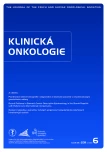HER2 positive T1N0M0 tumours: Time for a change?
Authors:
R. K. Rovere; Dos Santos Borges G.
Authors‘ workplace:
Department of Medical Oncology, Santo Antonio Hospital, Santa Catarina, Blumenau, Brazil
Published in:
Klin Onkol 2011; 24(6): 478
Category:
Letter to Editor
Introduction
Unarguably, breast cancer has been one of the types of cancer which has most benefited from the exponential raising in the armamentarium of new cancer drugs, mainly due to the discovery of compounds which target the HER 2 overexpressed subtypes, leading to lower recurrence rates in this population of patients [1,2] when administered in an adjuvant schedule for one year.
In the majority of those studies, the accrual criterion utilised was tumours with the diameter above one centimetre or with axillary lymph node invasion. Even though it has already been proven an enhanced aggressivity of HER 2 over expressing tumours in early clinical setting [3], still to this day the indication of adjuvant treatment remains only for tumours larger than one centimetre in the absence of lymph node commitment.
The present survey was then carried out to esteem the natural behaviour of this subkind of tumours as well as their main metastatic sites in a Brazilian cohort.
Methods
Six hundred and thirty three treated breast cancer patients have been identified in our oncology unit in the last five years. Of this group, 102 were HER 2 over expressed, and 16 had less than a centimetre of diameter with negative lymph node at the time of the surgery.
These patients were followed from the date of surgery until July 2011, looking for date and patterns of relapse. Patient’s electronic charts have been reviewed until this very same month utilising data from a single institution in the state of Santa Catarina, southern Brazil. All the patients were from the national health system of Brazil, in which our institution is the reference hospital for a population of over a million and a half lives.
Results
Out of 16 identified patients, eleven had had a relapse of the disease, as it follows: five patients with central nervous system metastasis, three with visceral metastasis (lung/liver), two with bone relapse and one local relapse, documented either by image or biopsy. To be noticed the fact that, in our data, all the relapses were diagnosed within the first year after the completion of the treatment, between one and 11 months.
Discussion
It goes without saying that the HER 2 overexpression is a clear indication of aggressivity, even in the T1N0M0 subgroup of patients, compared with their HER 2 negative counterparts, because, even though our study did not make a direct subgroups comparison, we can take account of historical controls of this disease.
It’s important to pinpoint that, due to the small number of subjects, definitive conclusions cannot be taken, but a good amount of evidence is produced, which should be sought in the future with possibly multicentric bigger trials.
In the absence of prospective randomised trials, it’s hard to advocate the unrestricted use of trastuzumab in this setting of patients, even though that, given the nature of the disease, in our opinion it’s urgently needed an adjuvant study in the subcentimetric group of patients, because of their high probability of benefit with trastuzumab.
Rodrigo Kraft Rovere, MD
Department of Medical Oncology
Santo Antonio Hospital
Santa Catarina, Blumenau
Brazil
e-mail: rodrigorovere@hotmail.com
Sources
1. Piccart-Gebhart MJ, Procter M, Leyland-Jones B et al. Trastuzumab after adjuvant chemotherapy in HER2-positive breast cancer. N Engl J Med 2005; 353(16): 1659–1672.
2. Romond EH, Perez EA, Bryant J et al. Trastuzumab plus adjuvant chemotherapy for operable HER2-positive breast cancer. N Engl J Med 2005; 353(16): 1673–1684.
3. Gonzalez-Angulo AM, Litton JK, Broglio KR et al. High risk of recurrence for patients with breast cancer who have human epidermal growth factor receptor 2-positive, node-negative tumors 1 cm or smaller. J Clin Oncol 2009; 27(34): 5700–5706.
Labels
Paediatric clinical oncology Surgery Clinical oncologyArticle was published in
Clinical Oncology

2011 Issue 6
Most read in this issue
- Castleman Disease
- Long Term Follow up of Eosinophilic Granuloma of the Rib
- Trabectedin Registry
- The Role of Chemotherapy and Targeted antiVEGF- and antiEGFR-Therapy in Metastatic Colorectal Cancer: a Case Report of Long-Term and Intensive Response
